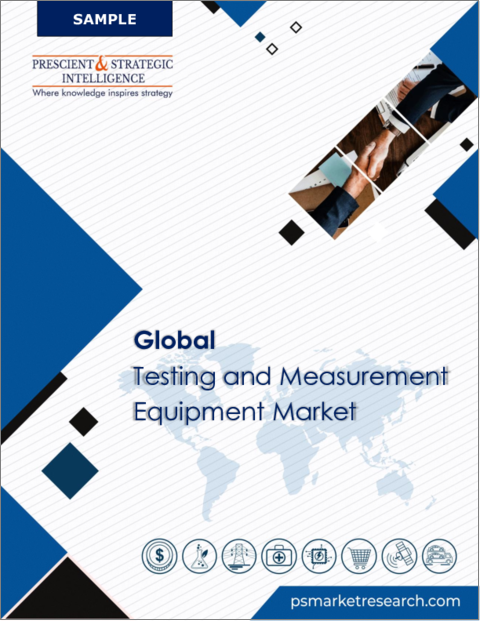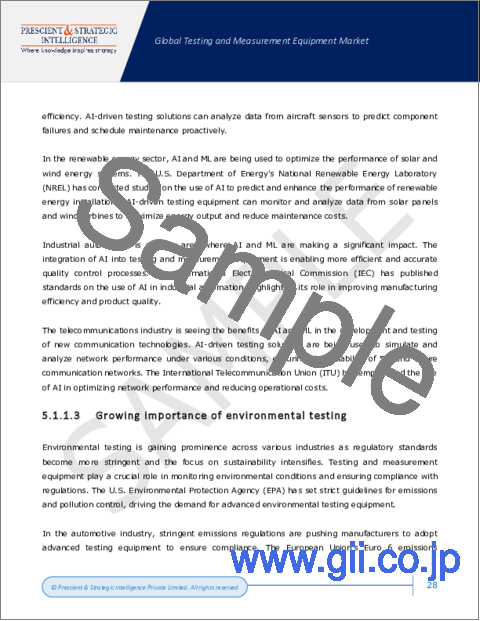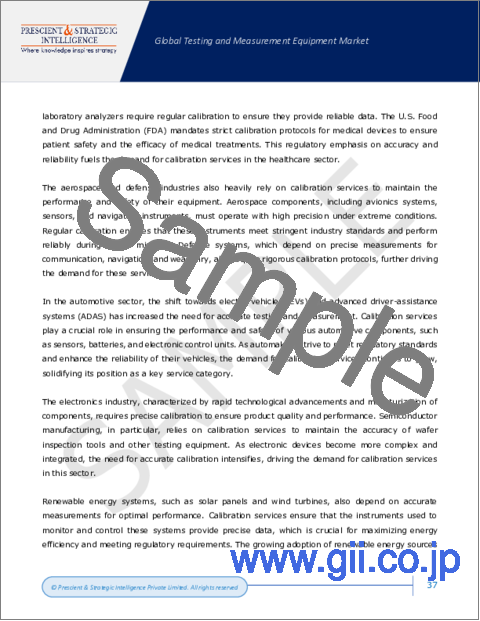|
|
市場調査レポート
商品コード
1463773
試験・計測機器の世界市場:市場規模・シェア分析 (技術別・サービス別・エンドユーザー別)、産業の需要予測 (~2030年)Testing and Measurement Equipment Market Size and Share Analysis by Technology, Service, End User - Global Industry Growth Forecast to 2030 |
||||||
|
|||||||
| 試験・計測機器の世界市場:市場規模・シェア分析 (技術別・サービス別・エンドユーザー別)、産業の需要予測 (~2030年) |
|
出版日: 2024年04月01日
発行: Prescient & Strategic Intelligence
ページ情報: 英文 270 Pages
納期: 2~3営業日
|
- 全表示
- 概要
- 目次
主なハイライト
世界の試験・計測機器市場は、2023年に348億米ドル、2030年には479億米ドルの規模に達し、4.5%以上のCAGRで成長する見通しです。
計測機器や試験機器のニーズは、新興国のエレクトロニクス部門を中心とした急速な産業成長によってもたらされています。
基本的に、航空宇宙・自動車・医療・通信などの分野での無線技術の組み込みの増加は、効果的な試験ソリューションの必要性を促進しています。
市場洞察
アジア太平洋は今後数年間、5.2%という最も高いCAGRで推進すると思われます。成長の背景には、インターネットユーザーの増加、半導体および自動車企業の出現、ITセクターの隆盛、業界プレイヤーの存在感の向上、大容量の製造拠点の存在があります。
GPTEカテゴリーは、2023年には約60%のシェアを占め、業界シェアが最大となった。これは主に、5Gネットワークの受け入れが増加したためと考えられます。
校正サービス部門は今後数年間、シェアが最大となる可能性が高いです。これらのサービスには、製品の精度維持と標準化が含まれ、信頼できるベンチマークと結果を保証します。
医療カテゴリーは今後数年間、CAGRが5.6%と最も高い伸びを示しそうです。これは、新しい医療機器の開発に重点が置かれているためです。
当レポートでは、世界の試験・計測機器の市場について分析し、市場の基本構造・最新情勢や主な促進・抑制要因、世界全体および地域別・主要国の市場規模の動向見通し (金額ベース、2017~2030年)、技術別・サービス別・エンドユーザー別の詳細動向、現在の市場競争の状況、主要企業のプロファイルなどを調査しております。
目次
第1章 調査範囲
第2章 調査手法
第3章 エグゼクティブサマリー
第4章 市場指標
第5章 業界の展望
- 市場力学
- 動向
- 促進要因
- 抑制要因/課題
- 促進要因/抑制要因の影響分析
- 新型コロナウイルス感染症 (COVID-19) の影響
- ポーターのファイブフォース分析
第6章 世界市場
- 概要
- 市場収益:技術別 (2017~2030年)
- 市場収益:サービス別 (2017~2030年)
- 市場収益:エンドユーザー別 (2017~2030年)
- 市場収益:地域別 (2017~2030年)
第7章 北米市場
- 概要
- 市場収益:技術別 (2017~2030年)
- 市場収益:サービス別 (2017~2030年)
- 市場収益:エンドユーザー別 (2017~2030年)
- 市場収益:国別 (2017~2030年)
第8章 欧州市場
第9章 アジア太平洋市場
第10章 ラテンアメリカ市場
第11章 中東・アフリカ市場
第12章 米国市場
- 概要
- 市場収益:技術別 (2017~2030年)
- 市場収益:サービス別 (2017~2030年)
- 市場収益:エンドユーザー別 (2017~2030年)
第13章 カナダ市場
第14章 ドイツ市場
第15章 フランス市場
第16章 英国市場
第17章 イタリア市場
第18章 スペイン市場
第19章 日本市場
第20章 中国市場
第21章 インド市場
第22章 オーストラリア市場
第23章 韓国市場
第24章 ブラジル市場
第25章 メキシコ市場
第26章 サウジアラビア市場
第27章 南アフリカ市場
第28章 アラブ首長国連邦 (UAE) 市場
第29章 競合情勢
- 市場参入企業とその提供品目の一覧
- 主要企業の競合ベンチマーク
- 主要企業の製品ベンチマーク
- 最近の戦略展開状況
第30章 企業プロファイル
- Fortive
- Keysight Technologies Inc.
- Rohde & Schwarz GmbH & Co. KG
- Advantest Corporation
- National Instruments Corporation
- VIAVI Solutions Inc.
- ANRITSU CORPORATION
- Yokogawa Electric Corporation
- EXFO INC.
第31章 付録
Key Highlights
The testing and measurement equipment market was valued at USD 34.8 billion in 2023, which will increase to USD 47.9 billion, advancing at more than 4.5% compound annual growth rate, by 2030.
The need for measuring as well as testing equipment is driven by the hasty industrial growth, particularly in the electronics sector in emerging economies.
This equipment plays a pivotal part in noticing defects in high-performance consumer electronics, such as those employed for wireless communication, optical communication, and microwave applications.
Safety and quality testing has become an important manufacturing stage with the decreasing size of electronic devices but with more advancement in their wireless capabilities.
The increase in the acceptance of wireless technologies, including Bluetooth, GPS, and Wi-Fi, globally is connecting businesses, governments, and people.
Essentially, the rise in the incorporation of wireless technologies in aerospace, automotive, healthcare, telecommunications, and some other sectors is driving the need for effective testing solutions.
The increasing acceptance of electric vehicles across the globe is correspondingly aiding testing equipment requirements as each automobile needs widespread testing before launch.
The major components of electric vehicles that must be ascertained in performance comprise the motor, on-board charger, and battery.
The related systems like back-office systems, telematics modules, and charging stations, need testing.
Market Insights
APAC is likely to propel at the highest compound annual growth rate, of 5.2%, in the years to come.
The growth in APAC is because of the increasing count of internet users, the advent of semiconductor and automotive firms, the flourishing IT sector, the improving presence of industry players, and the existence of high-capacity manufacturing sites.
The GPTE category was the largest contributor to the industry in 2023, with a share of approximately 60%. This can be primarily because of the rise in the acceptance of the 5G network.
GPTE measures the frequency, wattage, voltage, and various other functioning parameters of different electronic devices.
The increasing funding in the telecom sector is also aiding the growth of the GTPE category. India has seen large funding from key telecom firms for 4G service provision.
The calibration services category is likely to be the largest contributor to the industry in the years to come. These services include sustaining product precision and standardization, which guarantees dependable benchmarks and consequences.
The healthcare category is likely to propel at the highest compound annual growth rate, of 5.6%, in the years to come. This will be because of the robust emphasis on developing new medical equipment because they can encounter performance failures or decline, which could result in serious consequences.
To prevent such a problem, the utilization of testing equipment is likely to surge in the coming years.
The healthcare industry has observed substantial technological interventions over the last few years, such as the arrival of wearable devices like smartwatches.
Such devices allow the gathering of health data, enabling real-time monitoring of health and the proactive treatment of health conditions before symptoms develop.
The testing and measurement equipment industry is concentrated with recognized companies accounting for a significant share. However, growth in specific areas such as EV testing is likely to generate opportunities for new players.
Table of Contents
Chapter 1. Research Scope
- 1.1. Research Objectives
- 1.2. Market Definition
- 1.3. Analysis Period
- 1.4. Market Size Breakdown by Segments
- 1.4.1. Market size breakdown, by technology
- 1.4.2. Market size breakdown, by service
- 1.4.3. Market size breakdown, by end user
- 1.4.4. Market size breakdown, by region
- 1.4.5. Market size breakdown, by country
- 1.5. Market Data Reporting Unit
- 1.5.1. Value
- 1.6. Key Stakeholders
Chapter 2. Research Methodology
- 2.1. Secondary Research
- 2.1.1. Paid
- 2.1.2. Unpaid
- 2.1.3. P&S Intelligence database
- 2.2. Primary Research
- 2.3. Market Size Estimation
- 2.4. Data Triangulation
- 2.5. Currency Conversion Rates
- 2.6. Assumptions for the Study
- 2.7. Notes and Caveats
Chapter 3. Executive Summary
Chapter 4. Market Indicators
Chapter 5. Industry Outlook
- 5.1. Market Dynamics
- 5.1.1. Trends
- 5.1.2. Drivers
- 5.1.3. Restraints/challenges
- 5.1.4. Impact analysis of drivers/restraints
- 5.2. Impact of COVID-19
- 5.3. Porter's Five Forces Analysis
- 5.3.1. Bargaining power of buyers
- 5.3.2. Bargaining power of suppliers
- 5.3.3. Threat of new entrants
- 5.3.4. Intensity of rivalry
- 5.3.5. Threat of substitutes
Chapter 6. Global Market
- 6.1. Overview
- 6.2. Market Revenue, by Technology (2017-2030)
- 6.3. Market Revenue, by Service (2017-2030)
- 6.4. Market Revenue, by End User (2017-2030)
- 6.5. Market Revenue, by Region (2017-2030)
Chapter 7. North America Market
- 7.1. Overview
- 7.2. Market Revenue, by Technology (2017-2030)
- 7.3. Market Revenue, by Service (2017-2030)
- 7.4. Market Revenue, by End User (2017-2030)
- 7.5. Market Revenue, by Country (2017-2030)
Chapter 8. Europe Market
- 8.1. Overview
- 8.2. Market Revenue, by Technology (2017-2030)
- 8.3. Market Revenue, by Service (2017-2030)
- 8.4. Market Revenue, by End User (2017-2030)
- 8.5. Market Revenue, by Country (2017-2030)
Chapter 9. APAC Market
- 9.1. Overview
- 9.2. Market Revenue, by Technology (2017-2030)
- 9.3. Market Revenue, by Service (2017-2030)
- 9.4. Market Revenue, by End User (2017-2030)
- 9.5. Market Revenue, by Country (2017-2030)
Chapter 10. LATAM Market
- 10.1. Overview
- 10.2. Market Revenue, by Technology (2017-2030)
- 10.3. Market Revenue, by Service (2017-2030)
- 10.4. Market Revenue, by End User (2017-2030)
- 10.5. Market Revenue, by Country (2017-2030)
Chapter 11. MEA Market
- 11.1. Overview
- 11.2. Market Revenue, by Technology (2017-2030)
- 11.3. Market Revenue, by Service (2017-2030)
- 11.4. Market Revenue, by End User (2017-2030)
- 11.5. Market Revenue, by Country (2017-2030)
Chapter 12. U.S. Market
- 12.1. Overview
- 12.2. Market Revenue, by Technology (2017-2030)
- 12.3. Market Revenue, by Service (2017-2030)
- 12.4. Market Revenue, by End User (2017-2030)
Chapter 13. Canada Market
- 13.1. Overview
- 13.2. Market Revenue, by Technology (2017-2030)
- 13.3. Market Revenue, by Service (2017-2030)
- 13.4. Market Revenue, by End User (2017-2030)
Chapter 14. Germany Market
- 14.1. Overview
- 14.2. Market Revenue, by Technology (2017-2030)
- 14.3. Market Revenue, by Service (2017-2030)
- 14.4. Market Revenue, by End User (2017-2030)
Chapter 15. France Market
- 15.1. Overview
- 15.2. Market Revenue, by Technology (2017-2030)
- 15.3. Market Revenue, by Service (2017-2030)
- 15.4. Market Revenue, by End User (2017-2030)
Chapter 16. U.K. Market
- 16.1. Overview
- 16.2. Market Revenue, by Technology (2017-2030)
- 16.3. Market Revenue, by Service (2017-2030)
- 16.4. Market Revenue, by End User (2017-2030)
Chapter 17. Italy Market
- 17.1. Overview
- 17.2. Market Revenue, by Technology (2017-2030)
- 17.3. Market Revenue, by Service (2017-2030)
- 17.4. Market Revenue, by End User (2017-2030)
Chapter 18. Spain Market
- 18.1. Overview
- 18.2. Market Revenue, by Technology (2017-2030)
- 18.3. Market Revenue, by Service (2017-2030)
- 18.4. Market Revenue, by End User (2017-2030)
Chapter 19. Japan Market
- 19.1. Overview
- 19.2. Market Revenue, by Technology (2017-2030)
- 19.3. Market Revenue, by Service (2017-2030)
- 19.4. Market Revenue, by End User (2017-2030)
Chapter 20. China Market
- 20.1. Overview
- 20.2. Market Revenue, by Technology (2017-2030)
- 20.3. Market Revenue, by Service (2017-2030)
- 20.4. Market Revenue, by End User (2017-2030)
Chapter 21. India Market
- 21.1. Overview
- 21.2. Market Revenue, by Technology (2017-2030)
- 21.3. Market Revenue, by Service (2017-2030)
- 21.4. Market Revenue, by End User (2017-2030)
Chapter 22. Australia Market
- 22.1. Overview
- 22.2. Market Revenue, by Technology (2017-2030)
- 22.3. Market Revenue, by Service (2017-2030)
- 22.4. Market Revenue, by End User (2017-2030)
Chapter 23. South Korea Market
- 23.1. Overview
- 23.2. Market Revenue, by Technology (2017-2030)
- 23.3. Market Revenue, by Service (2017-2030)
- 23.4. Market Revenue, by End User (2017-2030)
Chapter 24. Brazil Market
- 24.1. Overview
- 24.2. Market Revenue, by Technology (2017-2030)
- 24.3. Market Revenue, by Service (2017-2030)
- 24.4. Market Revenue, by End User (2017-2030)
Chapter 25. Mexico Market
- 25.1. Overview
- 25.2. Market Revenue, by Technology (2017-2030)
- 25.3. Market Revenue, by Service (2017-2030)
- 25.4. Market Revenue, by End User (2017-2030)
Chapter 26. Saudi Arabia Market
- 26.1. Overview
- 26.2. Market Revenue, by Technology (2017-2030)
- 26.3. Market Revenue, by Service (2017-2030)
- 26.4. Market Revenue, by End User (2017-2030)
Chapter 27. South Africa Market
- 27.1. Overview
- 27.2. Market Revenue, by Technology (2017-2030)
- 27.3. Market Revenue, by Service (2017-2030)
- 27.4. Market Revenue, by End User (2017-2030)
Chapter 28. U.A.E. Market
- 28.1. Overview
- 28.2. Market Revenue, by Technology (2017-2030)
- 28.3. Market Revenue, by Service (2017-2030)
- 28.4. Market Revenue, by End User (2017-2030)
Chapter 29. Competitive Landscape
- 29.1. List of Market Players and their Offerings
- 29.2. Competitive Benchmarking of Key Players
- 29.3. Product Benchmarking of Key Players
- 29.4. Recent Strategic Developments
Chapter 30. Company Profiles
- 30.1. Fortive
- 30.1.1. Business overview
- 30.1.2. Product and service offerings
- 30.1.3. Key financial summary
- 30.2. Keysight Technologies Inc.
- 30.2.1. Business overview
- 30.2.2. Product and service offerings
- 30.2.3. Key financial summary
- 30.3. Rohde & Schwarz GmbH & Co. KG
- 30.3.1. Business overview
- 30.3.2. Product and service offerings
- 30.3.3. Key financial summary
- 30.4. Advantest Corporation
- 30.4.1. Business overview
- 30.4.2. Product and service offerings
- 30.4.3. Key financial summary
- 30.5. National Instruments Corporation
- 30.5.1. Business overview
- 30.5.2. Product and service offerings
- 30.5.3. Key financial summary
- 30.6. VIAVI Solutions Inc.
- 30.6.1. Business overview
- 30.6.2. Product and service offerings
- 30.6.3. Key financial summary
- 30.7. ANRITSU CORPORATION
- 30.7.1. Business overview
- 30.7.2. Product and service offerings
- 30.7.3. Key financial summary
- 30.8. Yokogawa Electric Corporation
- 30.8.1. Business overview
- 30.8.2. Product and service offerings
- 30.8.3. Key financial summary
- 30.9. EXFO INC.
- 30.9.1. Business overview
- 30.9.2. Product and service offerings
- 30.9.3. Key financial summary
Chapter 31. Appendix
- 31.1. Abbreviations
- 31.2. Sources and References
- 31.3. Related Reports






